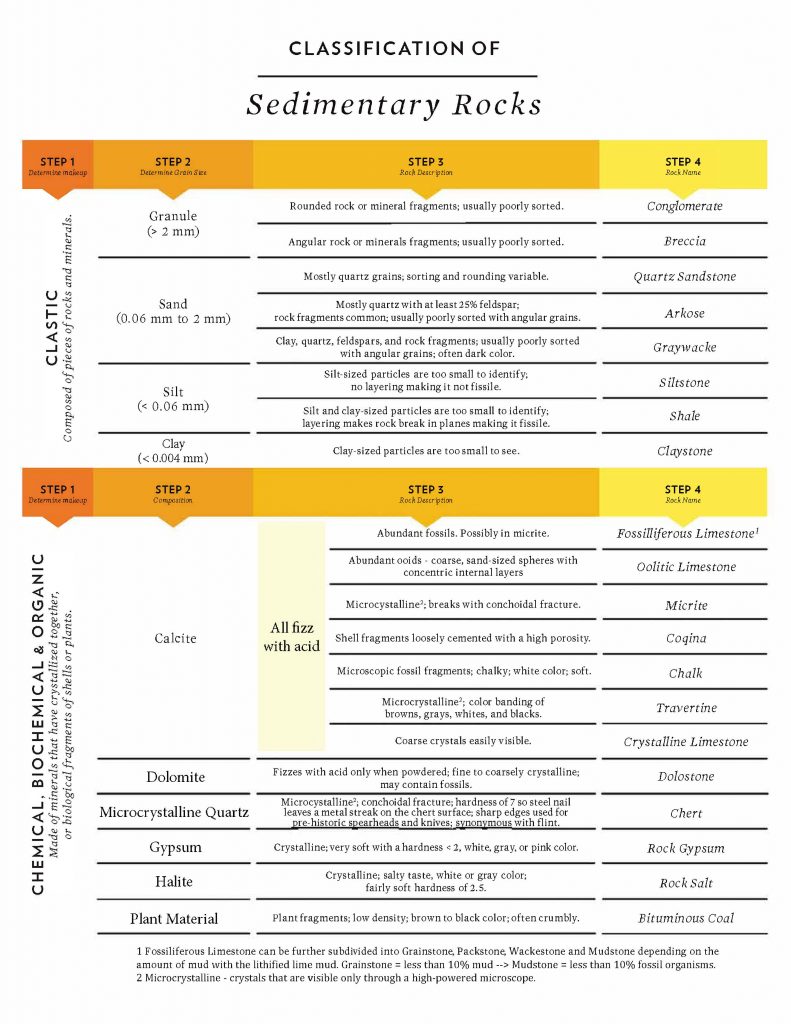
Photo by Richard Droker, CC-BY, via Flickr.
LEARNING OBJECTIVES
After reading this chapter, students should be able to:
- Describe the rock cycle
- Summarize the processes of formation of the three major groups of rocks (igneous, sedimentary, and metamorphic)
- Classify the three major groups of rocks based on their physical and chemical characteristics
The Rock Cycle
The rock components of the crust are slowly but constantly being changed from one form to another and the processes involved are summarized in the rock cycle. The rock cycle is driven by two forces: (1) Earth’s internal heat engine, which moves material around in the core and the mantle and leads to slow but significant changes within the crust, and (2) the Sun which powers the hydrological cycle, moving water, wind and air along Earth’s surface.
The rock cycle is still active on Earth because our core is hot enough to keep the mantle moving, our atmosphere is thick enough to support circulation, and we have liquid water. On some other planets or their satellites, such as the Moon, the rock cycle is virtually dead because the core is no longer hot enough to drive mantle convection and there is no atmosphere or liquid water.
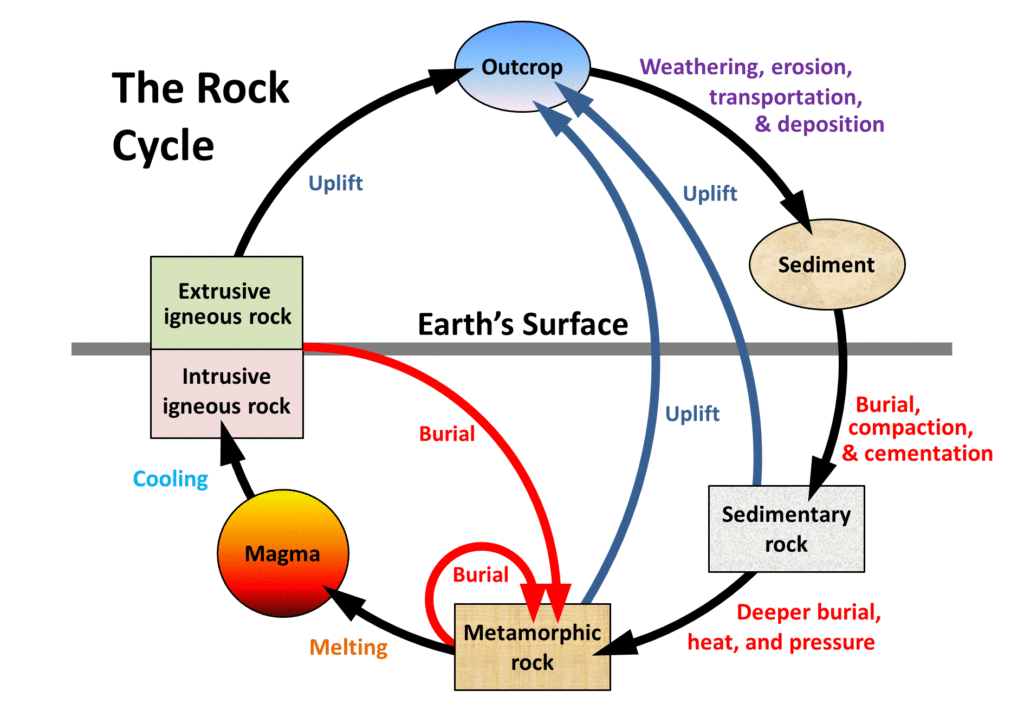
In describing the rock cycle, we can start anywhere we like, although it’s convenient to start with magma because from magma, new minerals and igneous rock are created. Magma is rock that has been heated to the point of being entirely molten. Magma can either cool slowly within the crust (over centuries to millions of years)—forming intrusive igneous rock, or erupt onto the surface, where it is called lava, and cool quickly (within seconds to years)—forming extrusive igneous rock (volcanic rock). Intrusive igneous rock typically crystallizes at depths of hundreds of meters to tens of kilometers below the surface.
Granite, an example of an igneous rock. Zoom in close to notice the interlocking fabric of minerals crystals of different size and shape. See if you can identify the common minerals: quartz, sodium-rich plagioclase, hornblende and biotite. Credit: Robin Rohrback, Mid-Atlantic Geo-Image Collection (M.A.G.I.C.) on GigaPan. CC BY Attribution 3.0
Plate tectonic processes of mountain building can allow for all types of rock to be uplifted and exposed at the surface. These include rock that is buried deep within the continents and even rock that is part of the crust of the deep ocean basins. Once rock of any type is exposed at the surface, it is attacked by the weathering agents of water, wind, ice and gravity. Rock is weathered, both physically (breaking into smaller pieces) and chemically (by alteration of the minerals). These weathering products—mostly small rock and mineral fragments—are eroded, transported, and then deposited as sediments. Transportation and deposition occur through the action of glaciers, streams, waves, wind, and other agents, and sediments are deposited in rivers, lakes, deserts, and the ocean. Sediments will eventually become buried by more sediments in some type of an accumulating basin. At depths of hundreds of meters or more, they become compressed and cemented into sedimentary rock.
Quartz sandstone, an example of a sedimentary rock. Zoom in close and notice the rounded quartz grains that are cemented together by white silica cement. The reddish color is the result of chemical weathering of minor iron minerals. Credit: Robin Rohrback, Mid-Atlantic Geo-Image Collection (M.A.G.I.C.) on GigaPan. CC BY Attribution 3.0
Any rock type that becomes buried deep within the crust is subjected to increasing heat and confining pressure. Tectonic forces of colliding plates can add additional stress to the buried rock. These changing conditions affect the stability of the pre-existing minerals and the fabric, or texture, of the original rock. This results in the formation of metamorphic rock.
Mica schist, an example of a metamorphic rock. Tiny muscovite mica minerals give this sample a “glittery” appearance. This metamorphic rock began its life as a clay rich sedimentary rock, like shale. Increased temperature and pressure conditions caused by mountain building deep within the crust caused the metamorphism. The black crystals are the iron-oxide mineral, magnetite. Credit: Robin Rohrback, Mid-Atlantic Geo-Image Collection (M.A.G.I.C.) on GigaPan. CC BY Attribution 3.0
Did I get it?
The Rock Cycle
Igneous Rock
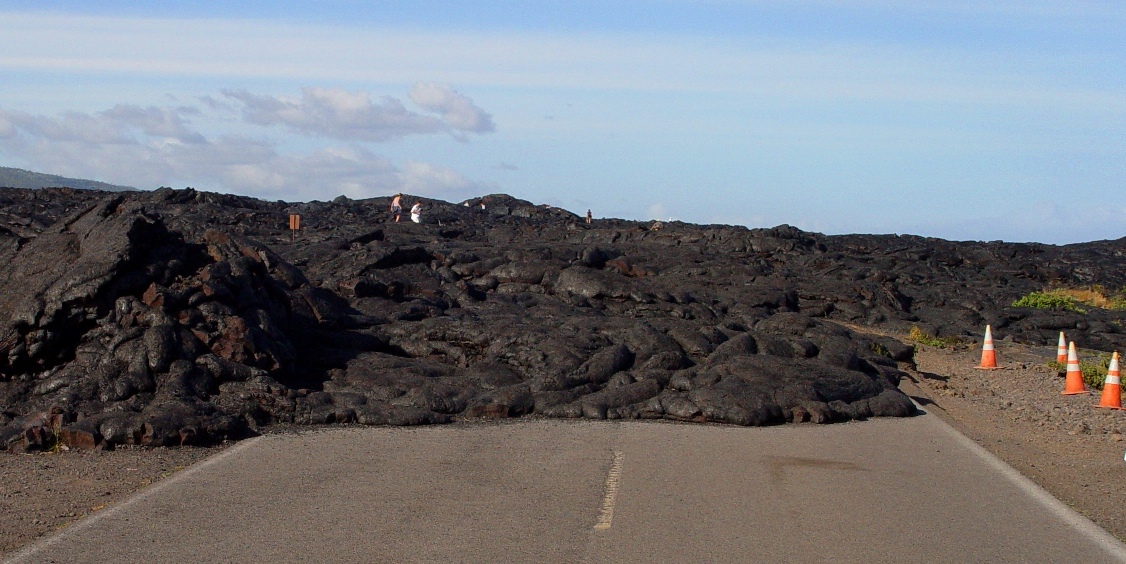
The temperature of magma can range between about 800° and 1600°C depending on where within the mantle the magma forms. Magma can either cool slowly within the crust (over centuries to millions of years)—forming intrusive igneous rock (also called plutonic rock), or erupt onto the surface and cool quickly (within seconds to years)—forming extrusive igneous rock (also called volcanic rock). Intrusive igneous rock typically crystallizes at depths of hundreds of meters to tens of kilometers below the surface.
Igneous Rock Classification
Igneous rocks are simply classified on two characteristics: composition and texture. The composition of igneous rocks is based on the minerals present viewed either with the naked eye or microscopically. For the classification based on composition, we return to Bowen’s Reaction Series. As we learned previously, the crystallization sequence of silicate minerals forming from a cooling magma follows the pattern outlined in Bowen’s Reaction Series.
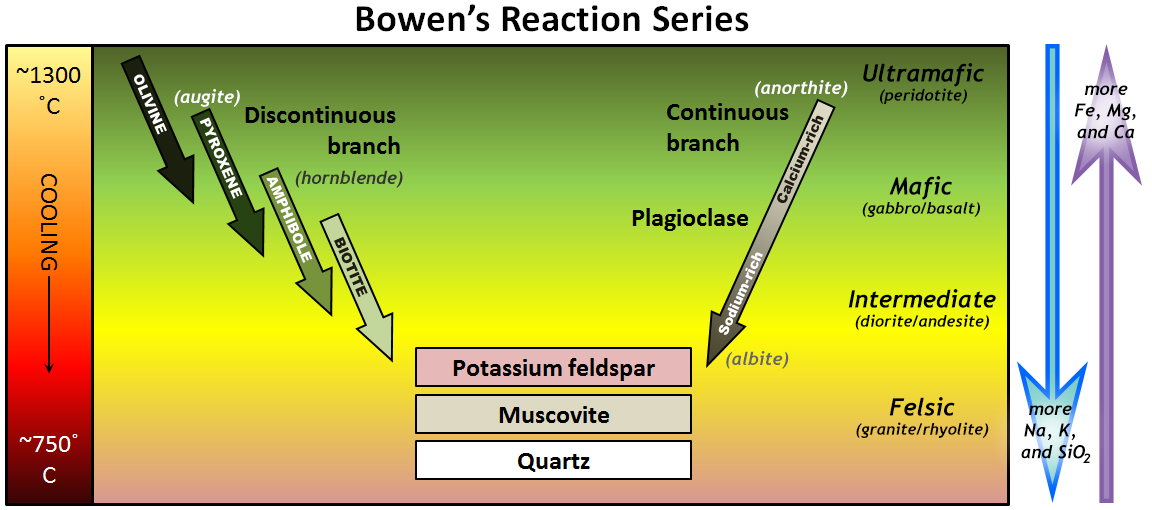
Igneous Rock Composition
Igneous rock composition is divided into four categories: ultramafic, mafic, intermediate and felsic. These categories refer to differing amounts of silica, potassium, sodium, calcium, iron, and magnesium found in the minerals that make up the rocks. Mafic refers to the overall composition being high in concentrations of magnesium (Mg) and iron (Fe). The minerals that compose mafic rocks are referred to as the ferromagnesian minerals, meaning, enriched in Fe and Mg. Felsic refers to the overall composition being enriched in the feldspar minerals of sodium-rich plagioclase and potassium feldspar plus silica (SiO2) in the form of quartz.
It is important to realize these groups do not have sharp boundaries in nature, but rather lie on a continuous spectrum with many transitional compositions and names that refer to specific quantities of minerals. On the Bowen’s Reaction Series diagram, we read these igneous rock compositions as horizontal strips that run from right to left. For example, mafic igneous rock will typically contain calcium-rich plagioclase plus varying amounts of the ferromagnesian minerals: olivine, pyroxene (augite) and amphibole (hornblende) minerals. Felsic igneous rock will typically contain sodium-rich plagioclase, biotite, potassium feldspar, muscovite and quartz.
Using the Bowen’s Reaction Series diagram alone does not allow us to classify igneous rocks beyond their general composition. To determine their specific classification, we use an enhanced diagram where composition is quantitatively determined by the percentage of each of Bowen’s minerals that occur in any given sample. Examine the top portion of the diagram below. In essence, this is Bowen’s Reaction Series Diagram rotated 90° to the right. Instead of ultramafic composition appearing along the top, as it does in Bowen’s Reaction Series, it exists along the right side of the diagram. The same minerals that we saw in Bowen’s Reaction Series that correspond to a rock of ultramafic composition, now exist in the far right column; they include a small percentage of calcium-rich plagioclase, and larger percentages of both pyroxene (augite), and olivine. On this diagram, Bowen’s Reaction Series sequence of mineral formation reads from right to left. This diagram helps us understand that rocks of any compositional category (ultramafic, mafic, intermediate and felsic) occur with varying percentages of Bowen’s Reaction Series minerals and though the compositional categories are separated by dashed lines, we can see that there are no hard and fast boundaries between each category.
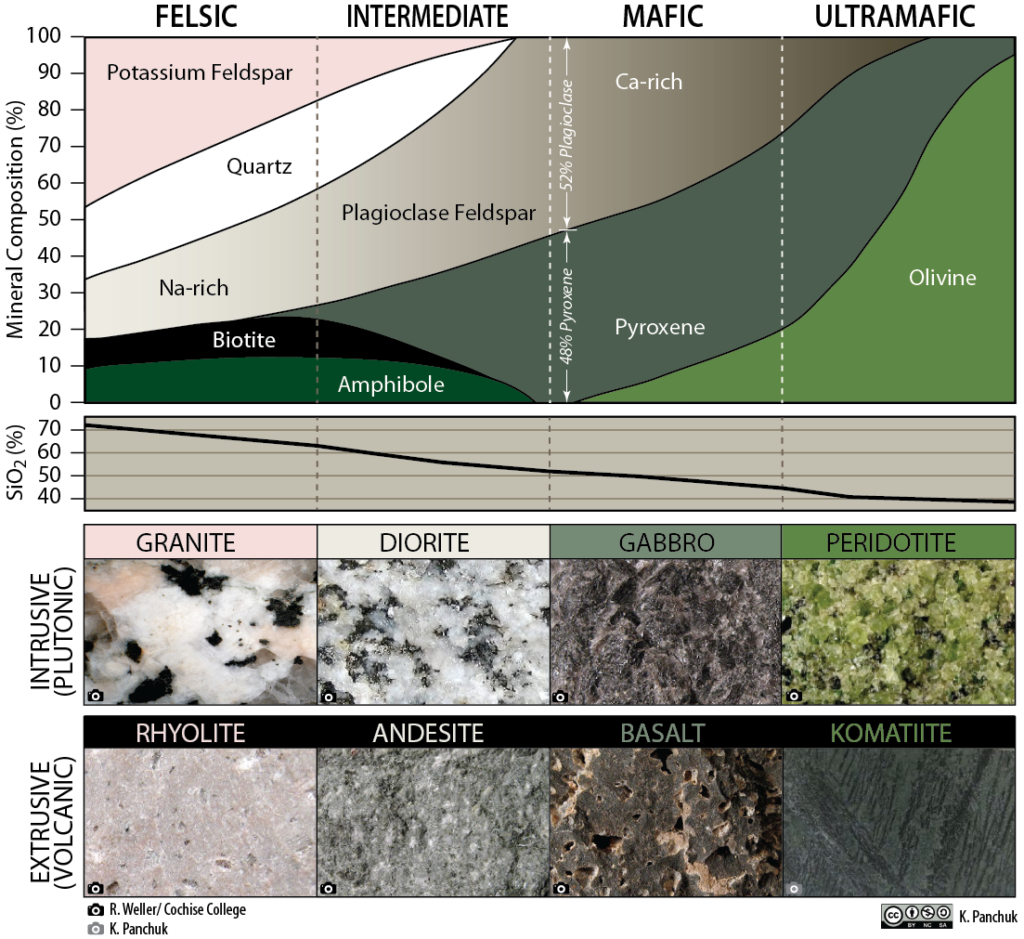
Ultramafic refers to the extremely mafic rocks composed of mostly olivine with lesser percentages of pyroxene and calcium-rich plagioclase. Rock of this composition is rarely found on Earth’s surface; Where outcrops do occur, they represent rock derived from the upper mantle. This rock is very high in iron and magnesium and poor in silica, in the 40% or less range.
Mafic refers to igneous compositions with an abundance of dark ferromagnesian minerals of olivine and augite plus gray calcium-rich plagioclase feldspar. The oceanic crust is primarily mafic rock. Mafic rock is low in silica, in the 45-50% range.
Intermediate is a composition between felsic and mafic. This rock type contains roughly equal amounts of light and dark minerals, including light grains of plagioclase feldspar and dark minerals like hornblende. Rock of this composition is commonly associated with convergent plate boundary volcanoes. The silica content in rock of intermediate composition is in the 55-60% range.
Felsic refers to a composition with a majority of the light-colored minerals feldspar and quartz. Minor amounts of dark-colored (ferromagnesian) minerals like amphibole and biotite mica may be present as well. Rock of this composition dominates the continental crust. Felsic igneous rock is rich in silica (in the 65-75% range) and poor in iron and magnesium.
Igneous Rock Texture
If magma cools slowly, deep within the crust, the resulting rock is called intrusive or plutonic. The slow cooling process allows crystals to grow large, giving intrusive igneous rock a coarse-grained or phaneritic texture. The individual mineral crystals are readily visible to the unaided eye.
When lava is extruded onto the surface, or intruded into shallow fissures near the surface and cools, the resulting igneous rock is called extrusive or volcanic. Extrusive igneous rocks have a fine-grained or aphanitic texture, in which the grains are too small to see with the unaided eye. The fine-grained texture indicates the quickly cooling lava did not have time to grow large crystals. These tiny crystals can be viewed using a special petrographic microscope used for viewing and magnifying very thin slices of rock (see photos below). In some cases, extrusive lava cools so rapidly it does not develop crystals at all. This non-crystalline material is volcanic glass which is a common component of volcanic ash and rocks like obsidian.
Hand sample of basalt. Note the aphanitic texture with no visible mineral grains. Credit: Robin Rohrback, Mid-Atlantic Geo-Image Collection (M.A.G.I.C.) on GigaPan. CC BY Attribution 3.0
This is a magnified view of a 30 micron thick slice of a sample of basalt rock using a petrographic microscope. All of the light gray, elongate crystals are plagioclase. The very bright blues and greens are olivine. The golden brown crystals are pyroxene (augite). Credit: Robin Rohrback, Mid-Atlantic Geo-Image Collection (M.A.G.I.C.) on GigaPan. CC BY Attribution 3.0
Once composition and texture are determined, the classification diagram can be used to give an igneous rock a name. The Igneous Rock Classification diagram (above) is read in columns. Let’s take a look at the “FELSIC” column on the left side of the diagram. As we move down the column we can see that felsic igneous rock will contain the following minerals in varying percentages: potassium feldspar, quartz, sodium-rich plagioclase, biotite and amphibole. The silica content (SiO2 %) will range between 65-75%. If it is an intrusive rock (plutonic) rock, it will have coarse, visible grains and it is given the name granite. If it is an extrusive rock (volcanic) rock with no visible (or few, very small) mineral grains, it is given the name rhyolite. Diorite and andesite likewise refer to intrusive and extrusive intermediate rock. Gabbro and basalt are the intrusive and extrusive names for mafic igneous rock. Peridotite is ultramafic and intrusive and komatiite as the fine-grained extrusive equivalent. Komatiite has been a rare rock because for most of Earth history, volcanic material that comes directly from the mantle is not common.
| Granite characteristics: Felsic composition, phaneritic texture, intrusive, plutonic. Credit: Robin Rohrback, Mid-Atlantic Geo-Image Collection (M.A.G.I.C.) on GigaPan. CC BY Attribution 3.0 | Rhyolite. Felsic composition, aphanitic texture, extrusive, volcanic. Credit: Robin Rohrback, Mid-Atlantic Geo-Image Collection (M.A.G.I.C.) on GigaPan. CC BY Attribution 3.0 |
| Diorite. Intermediate composition, phaneritic texture, intrusive, plutonic. Credit: Robin Rohrback, Mid-Atlantic Geo-Image Collection (M.A.G.I.C.) on GigaPan. CC BY Attribution 3.0 | Andesite. Intermediate composition, aphanitic texture, extrusive, volcanic. Special note: This texture is more correctly “porphyritic.” The large crystals formed early in the magma chamber prior to the volcanic eruption. The remaining rock cooled very quickly, preserving the early formed plagioclase crystals. Credit: Robin Rohrback, Mid-Atlantic Geo-Image Collection (M.A.G.I.C.) on GigaPan. CC BY Attribution 3.0 |
| Gabbro. Mafic composition, phaneritic texture, intrusive, plutonic. Credit: Robin Rohrback, Mid-Atlantic Geo-Image Collection (M.A.G.I.C.) on GigaPan. CC BY Attribution 3.0 | Basalt. Mafic composition, aphanitic texture, extrusive, volcanic. Credit: Robin Rohrback, Mid-Atlantic Geo-Image Collection (M.A.G.I.C.) on GigaPan. CC BY Attribution 3.0 |
| Peridotite. Ultramafic composition, aphanitic texture, intrusive, plutonic. Special note: This sample is called a xenolith. It is a piece of the mantle that was ripped away by magma making its way to the surface through a volcanic eruption. Credit: Robin Rohrback, Mid-Atlantic Geo-Image Collection (M.A.G.I.C.) on GigaPan. CC BY Attribution 3.0 |
Komatiite. Ultramafic composition, aphanitic texture, extrusive, volcanic. Credit: Callan Bentley, Mid-Atlantic Geo-Image Collection (M.A.G.I.C.) on GigaPan. CC BY Attribution 3.0 |
Did I get it?
Igneous Rocks
Sediments and Sedimentary Rocks
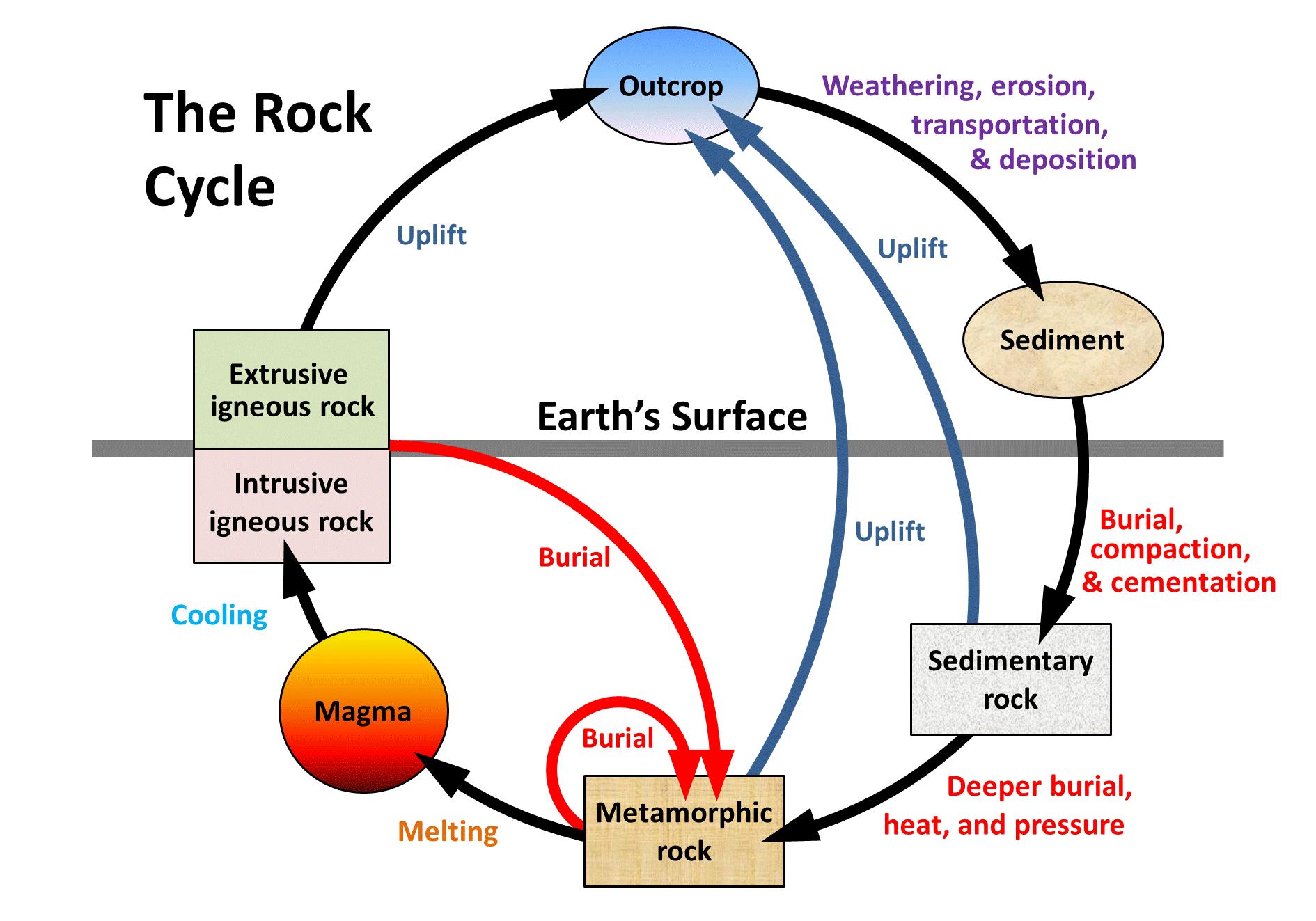
Sedimentary rock formation is a cycle unto itself and is discussed in more detail elsewhere in this text. The flow through that cycle appears below.

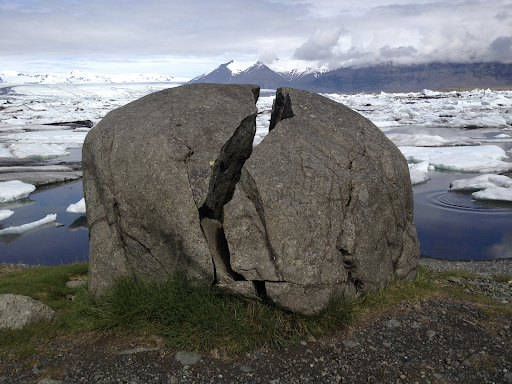
The cycle begins with the exposure of pre-existing rock to the “agents” of weathering and erosion. Weathering involves exposure of pre-existing rock to Earth’s surface weather conditions. These “agents” include wind, water and ice — plus gravity. Erosion is the removal of weathered rock material from its original location. The effects of weathering on pre-existing rock can be both physical and chemical.
Physical Weathering
Physical weathering is simply the process of physical disintegration: the breaking of solid rock into smaller pieces. The “agents” assist in this process which results in the exposure of an ever increasing number of surfaces to additional weathering.
Chemical Weathering
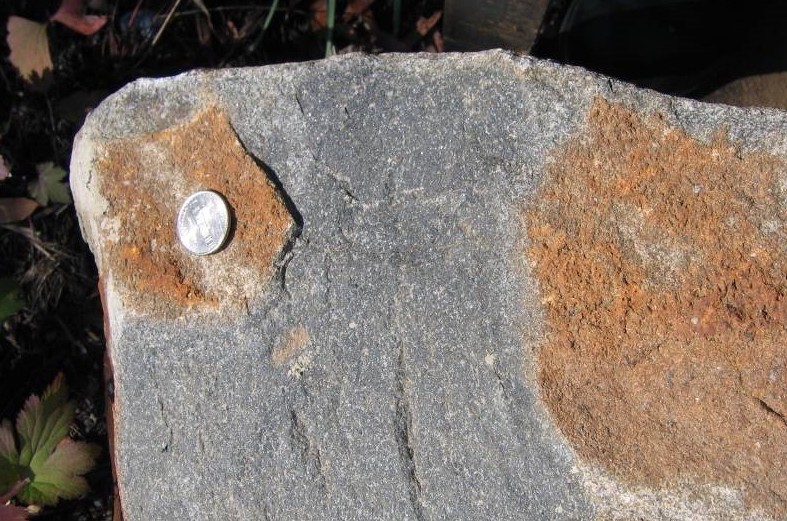
Chemical weathering produces changes in the chemistry of minerals in the pre-existing rock. These changes may result in new mineral formation through the addition or subtraction of elements from the original mineral structure or, in the further disintegration of the pre-existing minerals by chemical decomposition. The dominant agent involved in both physical and chemical weathering is water. Water acts as an agent of change, both introducing elements that can interfere with the chemistry of the exposed minerals and also acting as a flux, physically removing weathered rock material and ions lost through decomposition.
Weathering produces particles of sediment (of various sizes) plus ions in water. The sediment is transported to some setting where it gets deposited. This depositional location may be very close to the origin of the sediment (such as a rock fall off a cliff face) or many hundreds (or even several thousand) of kilometers away (for example the beach along the continental shoreline). Following deposition, the sediment is buried, compacted, and cemented together to form solid rock. We call these processes “diagenesis,” and collectively they serve to lithify the sediment into a rock.
The ions in solution (weathered chemical elements) can be:
-
-
- used in cementing particles sediment.
- extracted from the water to support life, both biochemical processes (in plants or animals) and in the formation of skeletal material, such as shells.
- precipitated from the water through supersaturation triggered by evaporation or by changing physical conditions of the surrounding water.
-
The importance of these processes to Historical Geology are discussed in much more detail elsewhere in this text. The simple classification of sedimentary rock is presented below.
Classification of Sedimentary Rocks
Clastic Sedimentary Rocks (Detrital)
Clastic sedimentary rock (also called ‘detrital’ sedimentary rock) consists of sediment pieces (clasts/rock detritus) that come from weathered bedrock, cemented together to make a new rock. The clastic sediment is often referred to as “siliciclastic” because it is derived from the rocks of the crust which, as we have learned, is largely composed of silicate minerals of igneous rock. Clastic (or detrital) rock is classified and named based on the size and composition of the clasts. Their various sizes, from boulders to clay, is referred to as the sediment grain size. The classification and description of the various clastic rocks appears in the top section of the chart below. The size, shape, and composition of the clasts varies widely based upon the source rock and the length of time the sediment has been moving through the system.
The classification and description of the various clastic sedimentary rock types appears in the top section of the chart below. Photos of each rock type appear beneath the chart.
Chemical, Biochemical and Organic Sedimentary Rock
Chemical sedimentary rock is formed by processes that do not directly involve mechanical weathering and erosion. Chemical weathering contributes the dissolved ions in water that ultimately form the various rock types. Inorganic chemical sedimentary rock is made of minerals precipitated from ions dissolved in solution. Inorganic chemical sedimentary rock forms in environments where ion concentration, dissolved gasses, temperatures, or pressures are changing, which causes minerals to crystallize, such as through the process of evaporation.
Biochemical sedimentary rock is formed from shells and bodies of underwater organisms (such as coral). The living organisms extract chemical components from the water and use them to build shells and other body parts. Biochemical sedimentary rocks are commonly composed of calcite, from a wide variety of sea life, or silica, largely from the single-celled microorganisms called radiolarian.
Organic sedimentary rock contains the remains of organic material that has undergone the lithification process. The source materials are plant and animal remains that are transformed through burial and heat, and end up as coal, oil, and methane (natural gas).
The classification and description of the various chemically formed sedimentary rock types appears in the bottom section of the chart below. Photos of each rock type appear beneath the chart.
Clastic Sedimentary Rock Photos
Conglomerate. A coarse-grained clastic sedimentary rock that is composed of a substantial fraction of rounded to subangular gravel-size clasts larger than 2 mm (0.079 in) in diameter. Conglomerates form by the consolidation and lithification of gravel. Conglomerates are typically poorly sorted and contain finer grained sediment, e.g., either sand, silt, clay or combination of them, called matrix by geologists, filling their interstices and are often cemented by calcium carbonate, iron oxide, silica, or hardened clay.
Photo credit: Callan Bentley, Mid-Atlantic Geo-Image Collection (M.A.G.I.C.) on GigaPan. CC BY Attribution 3.0. Definition credit: Wikipedia licensed under CC BY: 3.O Attribution.
Breccia. A coarse-grained clastic sedimentary rock that is composed of a substantial fraction of angular gravel-size clasts larger than 2 mm (0.079 in) in diameter. Breccias are typically poorly sorted and contain finer grained sediment, e.g., either sand, silt, clay or combination of them, called matrix by geologists, filling their interstices and are often cemented by calcium carbonate, iron oxide, silica, or hardened clay.
Photo credit: Callan Bentley, Mid-Atlantic Geo-Image Collection (M.A.G.I.C.) on GigaPan. CC BY Attribution 3.0. Definition credit: Wikipedia licensed under CC BY: 3.O Attribution.
Quartz sandstone. A clastic sedimentary rock composed mainly of sand-sized (0.0625 to 2 mm) quartz mineral grains. White and red (with iron oxide cement) are most common. Variable rounding and sorting. Photo credit: Callan Bentley, Mid-Atlantic Geo-Image Collection (M.A.G.I.C.) on GigaPan. CC BY Attribution 3.0. Definition credit: Wikipedia licensed under CC BY: 3.O Attribution.
Arkose sandstone. A clastic sedimentary rock composed mainly of sand-sized (0.0625 to 2 mm) feldspar mineral grains. Pink (potassium feldspar) and white (plagioclase feldspar) are most common. Commonly angular fragments with variable sorting.
Photo credit: Callan Bentley, Mid-Atlantic Geo-Image Collection (M.A.G.I.C.) on GigaPan. CC BY Attribution 3.0. Definition credit: Wikipedia licensed under CC BY: 3.0 Attribution.
Greywacke. A clastic sedimentary that is a variety of sandstone. It is generally characterized by its dark color, and poorly sorted angular grains of quartz, feldspar, and small rock fragments set in a compact, clay-fine matrix.
Photo credit: Callan Bentley, Mid-Atlantic Geo-Image Collection (M.A.G.I.C.) on GigaPan. CC BY Attribution 3.0. Definition credit: Wikipedia licensed under CC BY: 3.O Attribution.
Siltstone. A clastic sedimentary rock. As its name implies, it is primarily composed of silt sized particles, defined as grains < 0.06mm. Siltstones differ significantly from sandstones due to the smaller spaces available between the grains (pore space) and often contain a significant amount of clay. Although often mistaken as a shale, siltstone lacks the fissility (easy separation along flat bedding planes) and laminations which are typical of shale.
Photo credit: Callan Bentley, Mid-Atlantic Geo-Image Collection (M.A.G.I.C.) on GigaPan. CC BY Attribution 3.0. Definition credit: Wikipedia licensed under CC BY: 3.O Attribution.
Shale (with shell and plant fossils). A fine-grained, clastic sedimentary rock, composed of mud that is a mix of flakes of clay minerals and tiny fragments (silt-sized particles) of other minerals, especially quartz. Shale is characterized by breaks along parallel layering or bedding less than one centimeter in thickness, called fissility. It is the most common sedimentary rock.
Photo credit: Robin Rohrback, Mid-Atlantic Geo-Image Collection (M.A.G.I.C.) on GigaPan. CC BY Attribution 3.0. Definition credit: Wikipedia licensed under CC BY: 3.O Attribution.
Claystone

Claystone. A clastic sedimentary rock composed largely of clay, which measures less than 1/256 of a millimeter in particle size (not visible with the naked eye). Claystone is non-fissile, it does not break easily into layers like shale.
Ralph L. Dawes, Ph.D. and Cheryl D. Dawes, licensed under a Creative Commons Attribution 3.0 United States License.
Chemical, Biochemical and Organic Sedimentary Rock Photos
Presented in order on the chart.
Fossiliferous limestone is any type of limestone, made mostly of calcium carbonate (CaCO3) in the form of the minerals calcite, that contains an abundance of fossils or fossil traces. The fossils in these rocks may be of macroscopic or microscopic size. This particular sample contains an abundance of mollusc and gastropod fossils.
Photo credit: Robin Rohrback, Mid-Atlantic Geo-Image Collection (M.A.G.I.C.) on GigaPan. CC BY Attribution 3.0. Definition credit: Wikipedia licensed under CC BY: 3.O Attribution.
Oolitic Limestone is a type of limestone formed from ooids, small, spherical grains composed internally of calcium carbonate (CaCO3 – calcite) in concentric layers.
Photo credit: Robin Rohrback, Mid-Atlantic Geo-Image Collection (M.A.G.I.C.) on GigaPan. CC BY Attribution 3.0. Definition credit: Wikipedia licensed under CC BY: 3.O Attribution.
Micrite
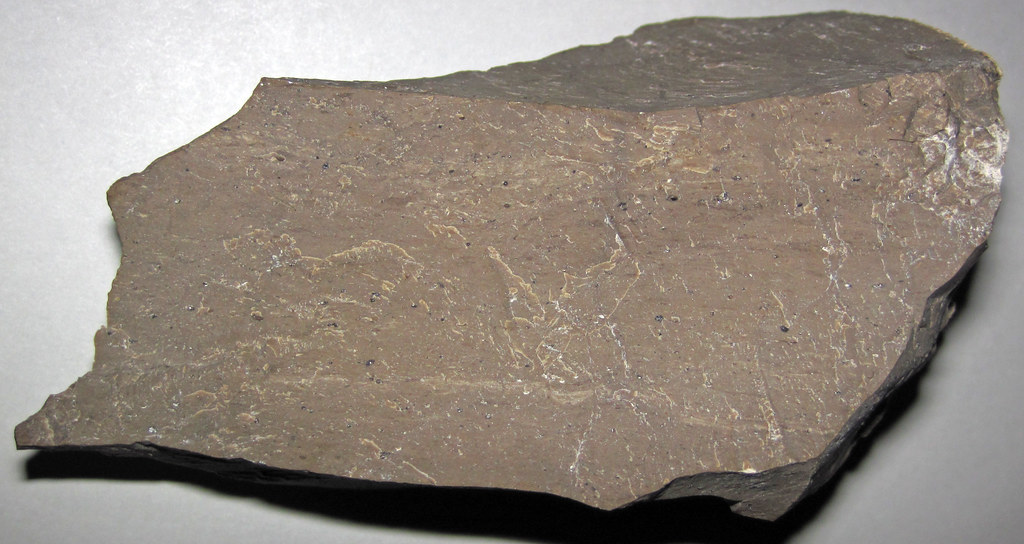
Micrite is a limestone formed of calcareous (composed of calcite) particles ranging in diameter up to four microns. It is formed by the recrystallization of calcareous mud.
“Fossiliferous dismicrite (Nineveh Limestone, Lower Permian; Clark Hill section, Long Ridge, Monroe County, Ohio, USA) 1” by James St. John is licensed under CC BY 2.0Definition credit: Wikipedia licensed under CC BY: 3.O Attribution.
Chalk
Chalk is a soft, white, porous, sedimentary carbonate rock, a form of limestone composed of the mineral calcite. It forms under reasonably deep marine conditions from the gradual accumulation of minute calcite shells (coccoliths) shed from micro-organisms called coccolithophores.
Photo credit: Robin Rohrback, Mid-Atlantic Geo-Image Collection (M.A.G.I.C.) on GigaPan. CC BY Attribution 3.0. Definition credit: Wikipedia licensed under CC BY: 3.O Attribution.
Travertine
Travertine is a form of limestone deposited by mineral springs, especially hot springs. Travertine is formed by a process of rapid precipitation of calcium carbonate, often at the mouth of a hot spring or in a limestone cave. In the latter, it can form stalactites, stalagmites, and other speleothems (as in the 3D model, above. Grab and rotate the sample to see it in 3D). Travertine can be white, tan, cream-colored, or somewhat rusty in color.
Crystalline Limestone
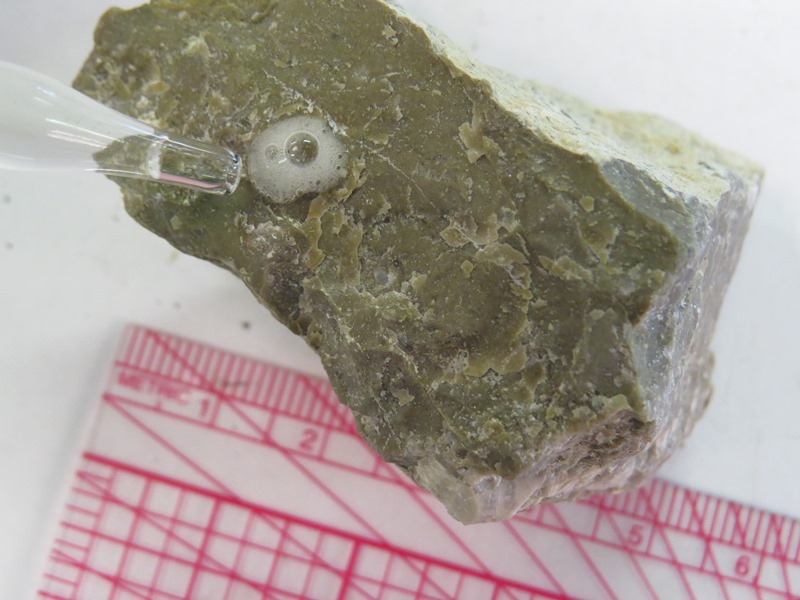
Crystalline limestone is a carbonate sedimentary rock that is composed of the precipitation of the mineral calcite (CaCO3) from saturated sea water. Its major materials are the minerals calcite and aragonite, which are different crystal forms of calcium carbonate (CaCO3). About 10% of sedimentary rocks are limestones.
Photo credit: Ralph L. Dawes, Ph.D. and Cheryl D. Dawes, licensed under a Creative Commons Attribution 3.0 United States License. Definition credit: Wikipedia licensed under CC BY: 3.O Attribution.
Dolostone
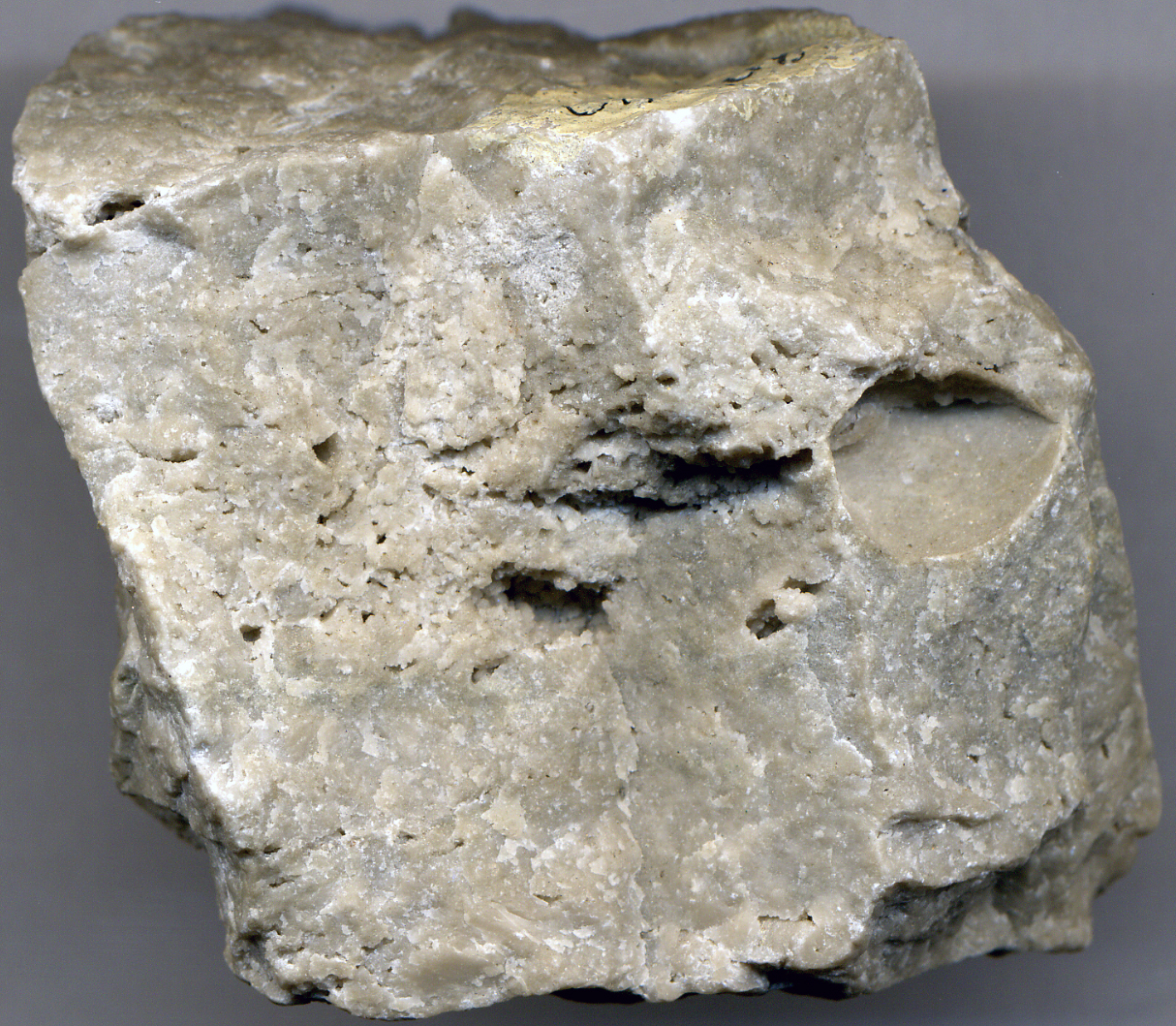
Dolostone is a sedimentary carbonate rock that contains a high percentage of the mineral dolomite, CaMg(CO3)2. Dolomite contains nearly equal amounts of magnesium and calcium. Most dolomites formed as a magnesium replacement of limestone or lime mud before lithification. Dolomite is less soluble than limestone and, for identification purposes, must first be scratched into a small power before it will effervesce with dilute hydrochloric acid.
Photo credit: “Dolostone (Silurian; midwestern USA)” by James St. John is licensed under CC BY 2.0Definition credit: Wikipedia licensed under CC BY: 3.O Attribution.
Chert (and Flint)
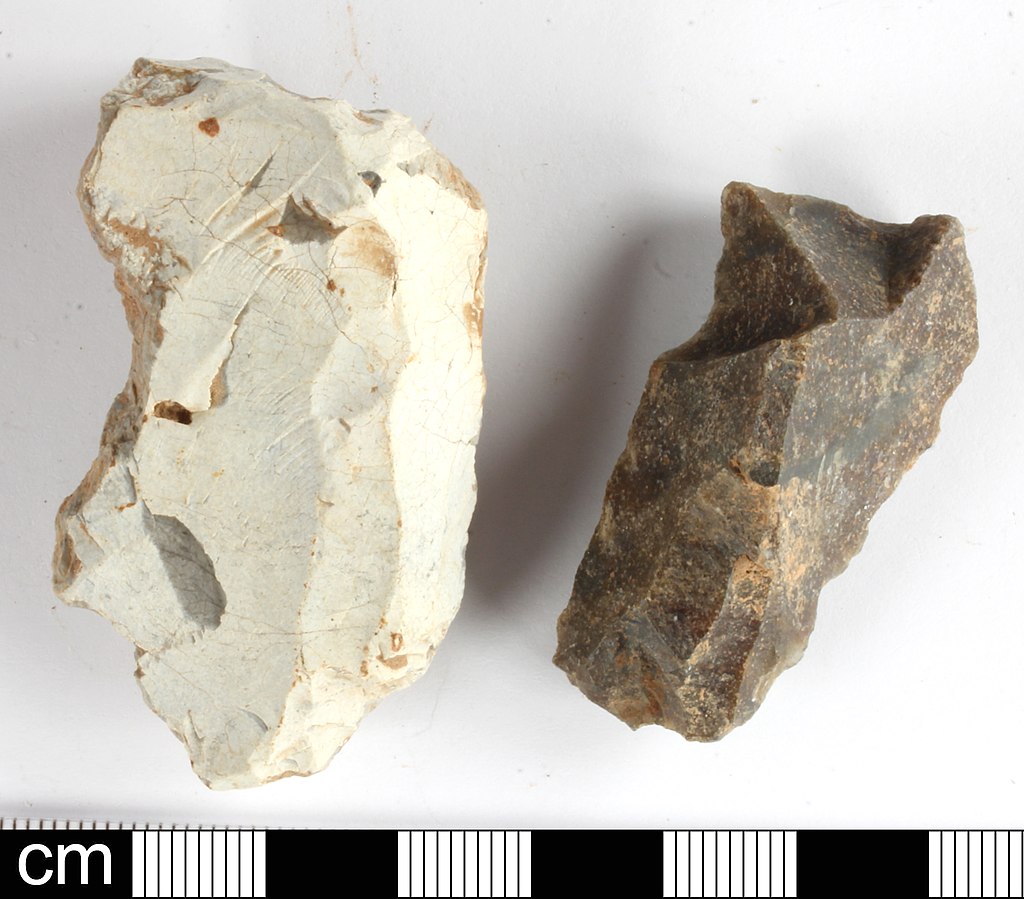
Chert is a hard, fine-grained sedimentary rock composed of crystals of quartz (silica SiO2) that are very small (microcrystalline or cryptocrystalline). It often breaks with a conchoidal fracture and was used to make sharp objects like knives and arrowheads in the prehistoric era. Chert is often of biological origin (organic) but may also occur inorganically as a chemical precipitate or a diagenetic replacement (e.g., petrified wood). Geologists use chert as a generic name for any type of microcrystalline or cryptocrystalline quartz. Varieties dark in color are called flint; red varieties are known as jasper; multi-colored and banded varieties are known as agate.
Photo credit: Ralph L. Dawes, Ph.D. and Cheryl D. Dawes, licensed under a Creative Commons Attribution 3.0 United States License. Definition credit: Wikipedia licensed under CC BY: 3.O Attribution.
Rock Gypsum
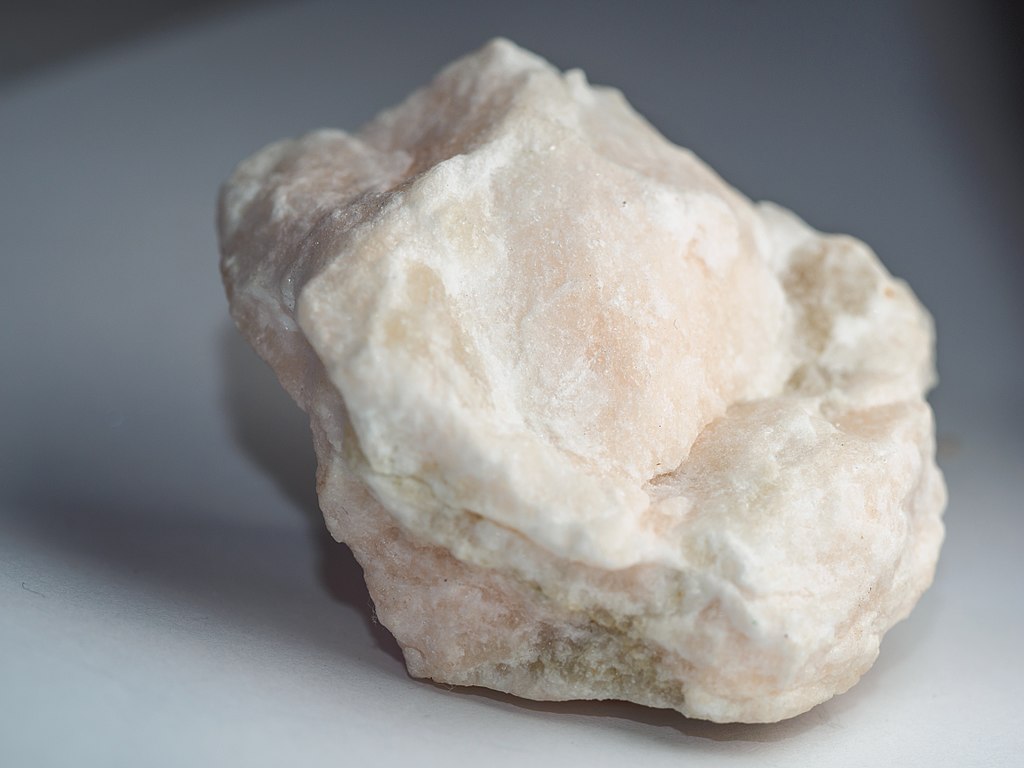
Rock gypsum is composed of the very soft mineral gypsum which defining characteristic is that it can be scratched with a fingernail. It is typically white to very pale pink or tan. Gypsum rock forms within layers of sedimentary rock from the slow evaporation of seawater.
James Petts From: Wikimedia is licensed under: Creative Commons Attribution-Share Alike 3.0 license.
Rock salt is composed of the mineral halite (sodium chloride, NaCl, common table salt) which defining characteristics include that it tastes salty and will dissolve readily in water. It is typically clear to white to pale pink or tan. Rock salt forms within layers of sedimentary rock from the slow evaporation of seawater.
Photo credit: Robin Rohrback, Mid-Atlantic Geo-Image Collection (M.A.G.I.C.) on GigaPan. CC BY Attribution 3.0. Definition credit: Wikipedia licensed under CC BY: 3.O Attribution.
Bituminous Coal 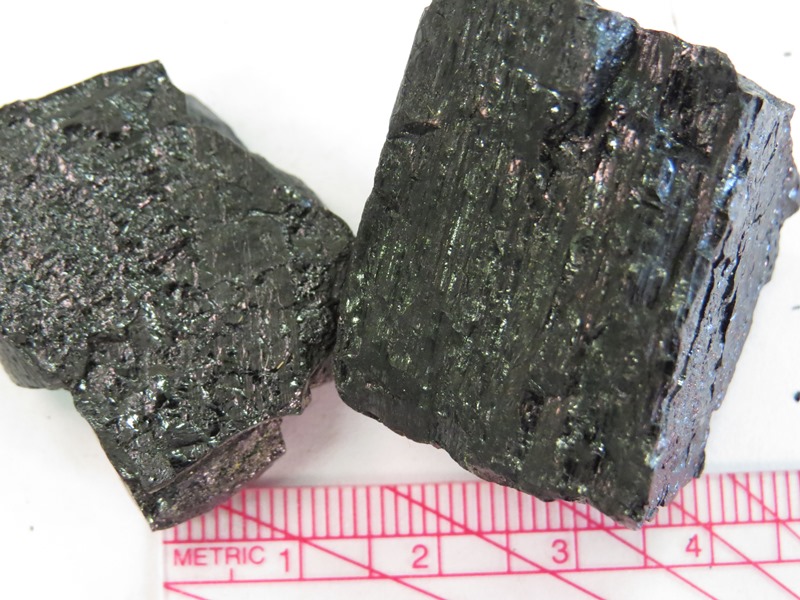
Bituminous coal is an organic sedimentary rock formed by diagenesis of peat bog material. Bituminous coal or black coal is a relatively soft coal containing a tar-like substance called bitumen. Its coloration can be black or sometimes dark brown; hard varieties may shine with an iridescent effect. The carbon content of bituminous coal is around 60–80%; the rest is composed of water, air, hydrogen, sulfur, and heavy metals such as lead, mercury, nickel, tin, cadmium, antimony, and arsenic, as well as radio isotopes of thorium and strontium. Nasty stuff! There is no such thing as “clean coal.”
Photo credit: Ralph L. Dawes, Ph.D. and Cheryl D. Dawes, licensed under a Creative Commons Attribution 3.0 United States License. Definition credit: Wikipedia licensed under CC BY: 3.O Attribution.
Did I get it?
Sedimentary Rock
Metamorphism and Metamorphic Rocks
Metamorphism is the change that takes place within a body of rock as a result of it being subjected to conditions that are different from those in which it formed. In most cases—but not all—this involves the rock being deeply buried beneath other rocks, where it is subjected to higher temperatures and pressures and no longer in equilibrium as it was in its original environment of formation. Metamorphism typically includes the recrystallization of minerals plus the formation of new minerals and different textures though often retaining the same overall chemical composition of the parent, or source rock. This parent rock is referred to as the protolith, from the Greek proto- meaning first, and lithos- meaning rock.
Most metamorphism is the result of tectonic forces during mountain building (orogenic) episodes. Plate collisions, especially continent to continent collisions, introduce tremendous stress and heat, take place over vast areas and last millions of years. These are the primary factors, or conditions needed to allow the dramatic changes to occur from protolith to metamorphic rock product.

The rock cycle, showing the processes related to metamorphic rocks at the bottom. CC BY: Steven Earle from: https://opentextbc.ca/physicalgeology2ed/part/chapter-7-metamorphism-and-metamorphic-rocks/
Types of Metamorphism
There are two primary environments that produce metamorphism that are important to Historical Geology:
Regional metamorphism. This occurs over a wide expanse of the crust, hundreds to more than a thousand kilometers across, resulting from the collision and compression of tectonic plates. Regional metamorphism can affect the pre-existing rock of the continental crust, any oceanic crust caught in the collision, plus the sedimentary rock cover that exists on each. Regional metamorphic processes can also affect the entire thickness of the crust and upper mantle and produce tremendous change in the pre-existing rock occurring tens of kilometers to several hundred kilometers deep.
Contact metamorphism is much simpler and affects pre-existing rock by baking them through contact with molten rock material either by intrusion of magma or extrusion of lava on the surface. Intrusion can occur very deep in the crust and involve large areas affected by heat associated with vast magma chambers. Intrusion can also be much smaller and take place closer to the surface or involve the baking of the surface rock through volcanic eruption of lava.
Metamorphic Processes
The main factors that control metamorphic change of pre-existing rock include:
-
-
- the mineral composition of the parent rock,
- the temperature at which metamorphism takes place,
- the amount and type of pressure during metamorphism,
- the types of fluids (mostly water) that are present during metamorphism, and
- the amount of time available for metamorphism.
-
Parent Rock (Protolith)
The parent rock is the rock that exists before metamorphism starts. As we see in the rock cycle, any type of rock can be a protolith including pre-existing metamorphic rock. The critical component of the parent rock is its mineral composition because it is the stability of each mineral that matters when metamorphism takes place. In other words, when a rock is subjected to increased temperatures, certain minerals may become unstable and begin to recrystallize in size, orientation or into completely new minerals.
Temperature
As we learned in the previous discussions of Bowen’s Reaction Series, minerals gain stability as temperature cools. Minerals remain stable over a specific range of temperature. For example, quartz is stable under all surface environmental temperatures will remain stable all the way up to about 1800°C. On the other hand, most clay minerals are only stable up to about 150° or 200°C; above that, they transform into micas. Feldspar, the most common mineral of the crust, is stable up to approximately 1200°C.
Pressure
Pressure is the force exerted on the protolith by burial and/or tectonic stresses. Like heat, pressure can affect the chemical equilibrium of minerals in a rock. The pressure that affects metamorphic rocks can be grouped into confining pressure and directed stress. Stress is a scientific term indicating a force. Strain is the result of this stress, including metamorphic changes within minerals.
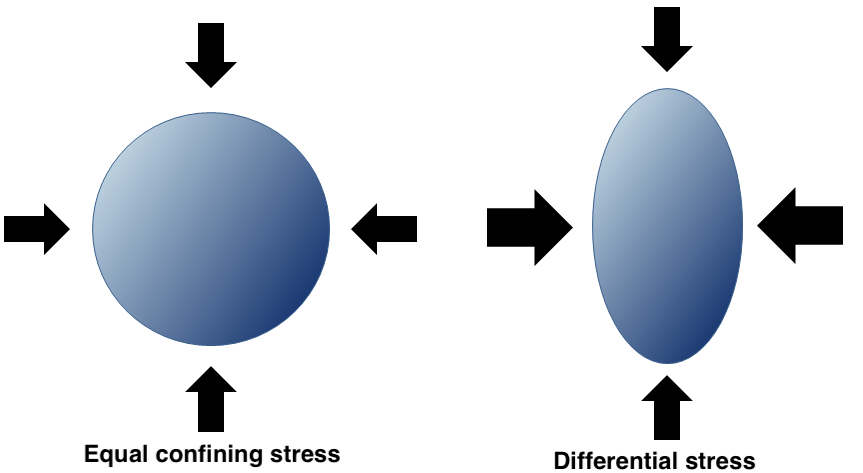
Confining Pressure
Pressure exerted on rocks under the surface is due to the simple fact that rocks lie on top of one another. When pressure is exerted from rocks above, it is balanced from below and sides, and is called confining or lithostatic pressure. Confining pressure results in equal pressure on all sides (see figure) and is responsible for causing chemical reactions to occur just like heat. These chemical reactions will cause new minerals to form.
Differential Stress
Differential stress is an unequal balance of forces on the protolith in one or more directions (see previous figure). Differential stress is most commonly associated with the tectonic movement of plates during mountain building (orogeny). Differential stress modifies the parent rock at a mechanical level, changing the arrangement, size, and/or shape of the mineral crystals. This creates an identifying texture, known as foliation, which is shown in the figure below.
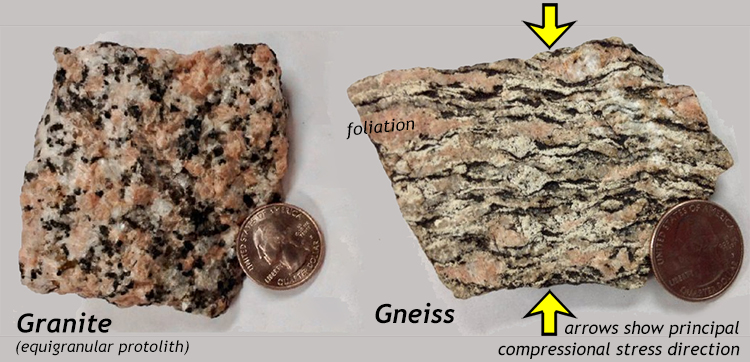
Differential stress produces rock textures with a visible parallel alignment. In response to the differential stress, mineral crystals can rotate, changing their orientation in space. This is a process of recrystallization in a solid state. The atomic structure of the mineral will respond to the stress and atoms will migrate within the structure in response to the stress. A good example would be the reorientation of the mineral biotite in the samples above. Biotite is a black, sheet silicate that can be easily peeled apart in thin layers. The biotite crystals are randomly oriented in the igneous granite sample on the left. When subjected to the differential stress of tectonic forces, the biotite crystals will realign perpendicular to the directions of stress providing the visually foliated metamorphic rock texture.
Recrystallization can also lead to minerals increasing in grain size as atoms migrate from an area of rock experiencing high stress and precipitate or regrow in a location having lower stress. You can visualize this similar to the phenomenon that occurs with small, adjacent soap bubbles coalesce to form larger ones. A good example of this would be the recrystallization of calcite that occurs in the metamorphism of limestone to marble (below). Note the crystalline fabric of the marble on the right versus the very fine mud-like texture of the sedimentary limestone, micrite, on the left.
Laminated micrite (left) compared to a crystalline banded marble (right). Credit: Robin Rohrback, Mid-Atlantic Geo-Image Collection (M.A.G.I.C.) on GigaPan. CC BY Attribution 3.0
Fluids
Water is the main fluid present within rocks of the crust. Water facilitates the movement of ions within the protolith being subjected to metamorphic conditions. Water assists in metamorphic mineral growth and also acts as a catalyst that can increase the rate at which metamorphic reactions take place.
Time
Most metamorphic reactions take place at very slow rates. For example, the growth of new minerals within a rock during metamorphism has been estimated to be about 1 millimetre per million years. For this reason, it is very difficult to study metamorphic processes in a lab.
While the rate of metamorphism is slow, the tectonic processes that lead to metamorphism are also very slow, so in most cases, the chance for metamorphic reactions to be completed is high. A mountain range takes tens of millions of years to form, and tens to hundreds of millions of years to be eroded to the extent that we can see the rocks that were metamorphosed within the deep interior.
Classification of Metamorphic Rocks
Metamorphic rocks are classified based on two characteristics: Texture and Composition. Texture is first characteristic observed in the identification process. There are two main types of metamorphic rocks:
Foliated: formed in an environment subjected to differential stress resulting in a distinct alignment of minerals. Foliated metamorphic rocks are named based on the style of their foliations. Each rock name has a specific texture that defines and distinguishes it.
Non-foliated: either not subjected to directed pressure or, the dominant mineral does not tend to display any alignment.

Foliated Metamorphic Rocks

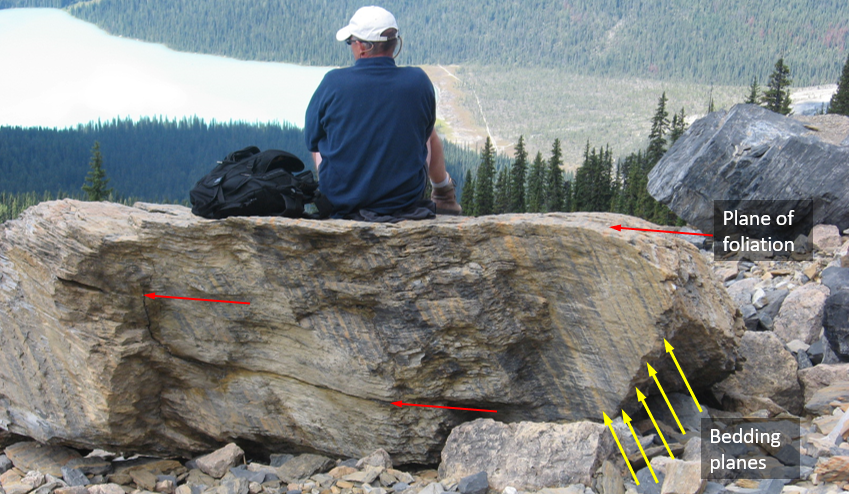
Slate is a fine-grained metamorphic rock that exhibits a foliation called slaty cleavage that is the flat orientation of the small platy crystals of mica and chlorite recrystallized perpendicular to the direction of stress. The minerals in slate are too small to see with the unaided eye. The thin layers in slate may resemble sedimentary bedding, but they are a result of differential stress and may lie at angles to the original strata (see photo below). In fact, original sedimentary layering may be partially or completely obscured by the foliation. The protolith for slate was a shale-type sedimentary rock composed of clay. Slate represents low-grade metamorphism.
Phyllite is also a fine-grained foliated metamorphic rock in which the platy chlorite and mica minerals have grown larger and the surface of the foliation shows a sheen from light reflecting from the grains. The texture is “phylittic” where we can detect an increase in size of the minerals over slate however the individual minerals are still too small to be differentiated with the naked eye.
Phyllite displaying “phylittic” texture. Note displaying cross-bedding of the sedimentary protolith. Credit: Robin Rohrback, Mid-Atlantic Geo-Image Collection (M.A.G.I.C.) on GigaPan. CC BY Attribution 3.0
Schist. The metamorphic rock schist displays a “shistose” foliation in which the minerals are now visible as individual crystals. Common minerals are muscovite, biotite, and porphyroblasts of garnets. A porphyroblast is a large crystal of a particular mineral surrounded by small grains. Varieties of schist are named for their dominant minerals such as mica schist (mostly micas) or garnet mica schist (mica schist with garnets).
| Biotite schist displaying coarse-grained “schistose” texture. Credit: Robin Rohrback, Mid-Atlantic Geo-Image Collection (M.A.G.I.C.) on GigaPan. CC BY Attribution 3.0 |
Garnet Mica Schist (both biotite and muscovite). Also displaying the coarse-grained “schistose” texture with large porphyroblasts of garnet. Credit: Callan Bentley, Mid-Atlantic Geo-Image Collection (M.A.G.I.C.) on GigaPan. CC BY Attribution 3.0 |
Gneiss and Migmatite. Mineral banding in a metamorphic rock produces a “gneissic” foliation in which visible silicate minerals separate into dark and light bands. The mineral grains tend to be coarse and the bands are often folded due to the extreme pressure and temperature conditions at which this type of metamorphic rock forms. A rock with this texture is called gneiss. Some gneisses may be subjected to temperatures at which partial melting can occur. This partially melted rock is a transition between metamorphic and igneous rocks called a migmatite. The melting will affect the minerals in the gneiss formed at the lowest temperatures on Bowen’s Reaction Series (quartz and potassium feldspar) and will collect in small lenses within the migmatite.
(Top) Muscovite, biotite, garnet gneiss displaying “gneissic” foliation. (Bottom) Migmatite. Credit: Robin Rohrback, Mid-Atlantic Geo-Image Collection (M.A.G.I.C.) on GigaPan. CC BY Attribution 3.0
Non-foliated Metamorphic Rocks
Non-foliated textures do not display alignment of mineral grains. Non-foliated metamorphic rocks are typically composed of just one mineral, and therefore, usually show the effects of metamorphism with recrystallization in which crystals grow together, but with no preferred direction. The two most common examples of non-foliated rocks are quartzite and marble.
Amphibolite is the result of metamorphism of a mafic igneous protolith. This may have originally been basalt or gabbro with olivine, pyroxene (augite) and calcium-rich plagioclase. The dominant mineral now is amphibole (hornblende). Zoom in on this sample and you will also see the green clay mineral chlorite.
Greenstone is a fine grained metamorphic rock that is largely composed of the green chlorite mineral plus other typically green metamorphic minerals, epidote and serpentine. The protolith of a greenstone is most commonly the mafic igneous rock, basalt. The original fine grained, iron and magnesium rich, minerals of olivine and pyroxene have recrystallized through metamorphic processes to form the greenstone rock. Greenstone is very important to Historical Geology, preserving some of the oldest slivers of early ocean crust. This is discussed in much more detail elsewhere in this text. The photo on the left, below is a hand sample of greenstone taken from the outcrop location on the right. Zoom into the sample on the left to see the fine-grained green minerals. Zoom into the photo on the left to get a feel for the metamorphic fabric and overall green color of the rock.
Left photo Credit: Robin Rohrback; right photo credit: Callan Bentley, Mid-Atlantic Geo-Image Collection (M.A.G.I.C.) on GigaPan. CC BY Attribution 3.0;
Quartzite and Marble
| Quartzite is a metamorphic rock with the protolith being quartz sandstone. In quartzite, the quartz grains and silica cement of the original sandstone become fused and interlocking by the recrystallization process. Zoom in and note the cohesive fabric produced by the interlocking crystals of quartz. Credit: Callan Bentely, Mid-Atlantic Geo-Image Collection (M.A.G.I.C.) on GigaPan. CC BY Attribution 3.0 | Marble is metamorphosed limestone (or dolostone) composed of calcite (or dolomite). Recrystallization typically generates visible interlocking crystals of calcite or dolomite.
Credit: Robin Rohrback, Mid-Atlantic Geo-Image Collection (M.A.G.I.C.) on GigaPan. CC BY Attribution 3.0 |
| Marble and quartzite often look similar however there are simple tests that can distinguish the two. First, the quartz minerals that compose the quartzite are considerably harder than the calcite that composes the marble. A simple hardness test on a piece of glass will show that quartz will scratch the glass, however calcite will not. Another way to easily distinguish quartzite from marble is with a drop of dilute hydrochloric acid. Marble will effervesce (fizz) because it is made of calcite. Remember to scratch the sample to make a little powder and then use a drop of hydrochloric acid to test. It will slowly effervesce if it is a dolomite marble. | |
Did I get it?
Metamorphic rock
